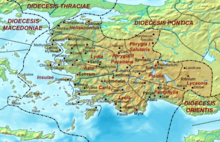|
Stratonicea (Lydia) Stratonicea – (Greek: Στρατoνικεια, or Στρατονίκεια) also transliterated as Stratoniceia and Stratonikeia, earlier Indi, and later for a time Hadrianapolis – was an ancient city in the valley of the Caicus river, between Germe and Acrasus, in Lydia, Anatolia; its site is currently near the village of Siledik, in the district of Kırkağaç, Manisa Province, in the Aegean Region of Turkey. DescriptionThe foundation of the city dates from the Hellenistic period, probably on the site of an older settlement, Indi. One source names Eumenes II as the founder, who named the city after his wife, Stratonice. However, as several Seleucid leaders also had wives named "Stratonice", the identification of the actual founder is not unchallenged. In antiquity, Stratonicea minted its own coins from the late 2nd century BC irregularly until the reign of Gallienus, in the mid-3rd century AD.[1][2] By 130 BC, Thyatira had annexed the city which had become merely a village. Stratonicea regained importance during Trajan's reign. Emperor Hadrian renamed the city Hadrianopolis after himself. Archaeological finds from the site are preserved in a museum in Manisa.[3]
BishopricThe ancient bishopric of Stratonicea in Lydia is included in the Catholic Church's list of titular sees.[4] The only titular bishop of the see was Alphonse Bermyn, who was appointed on 15 April 1901 and died on 16 February 1915.[5] Known Bishops
References
|